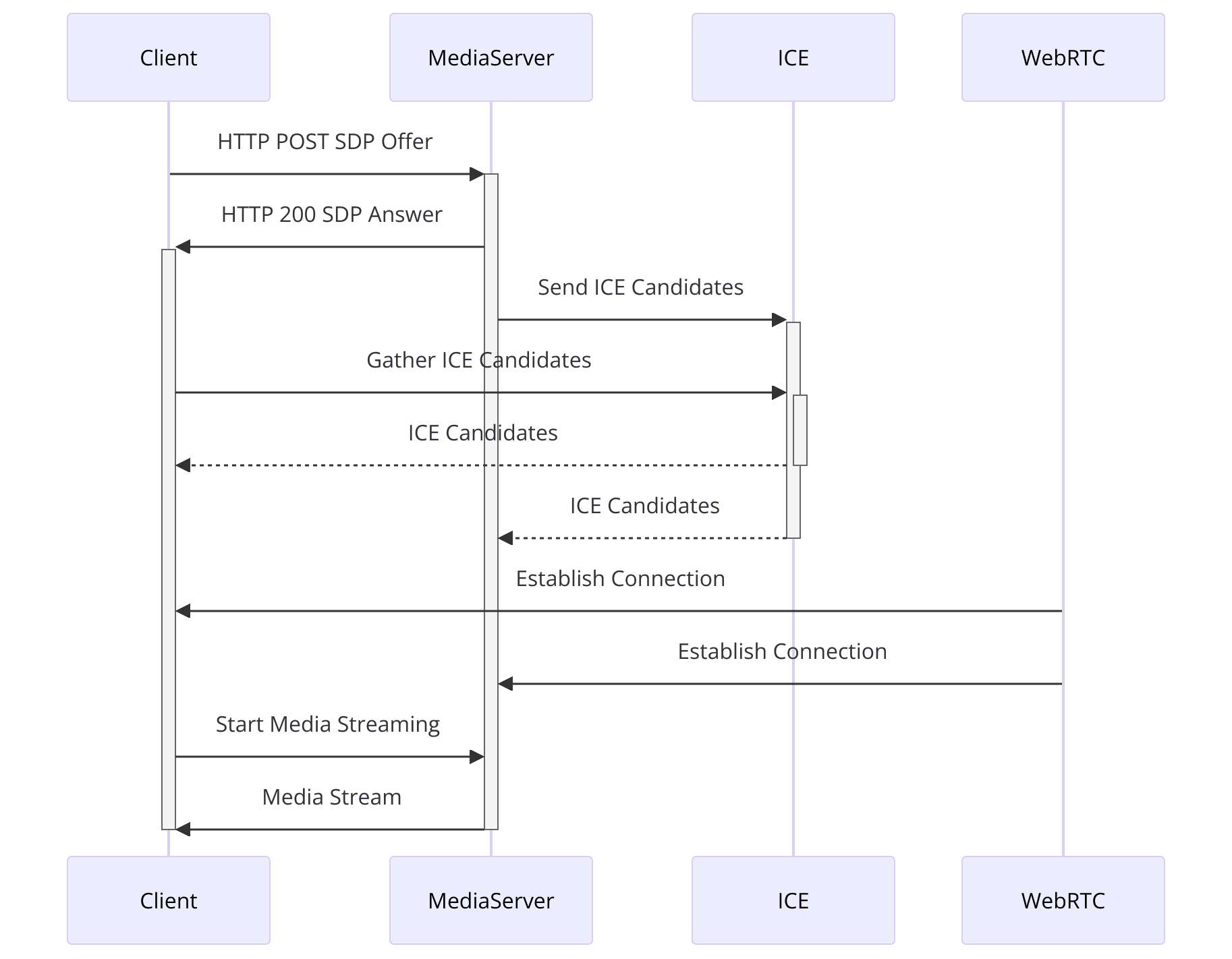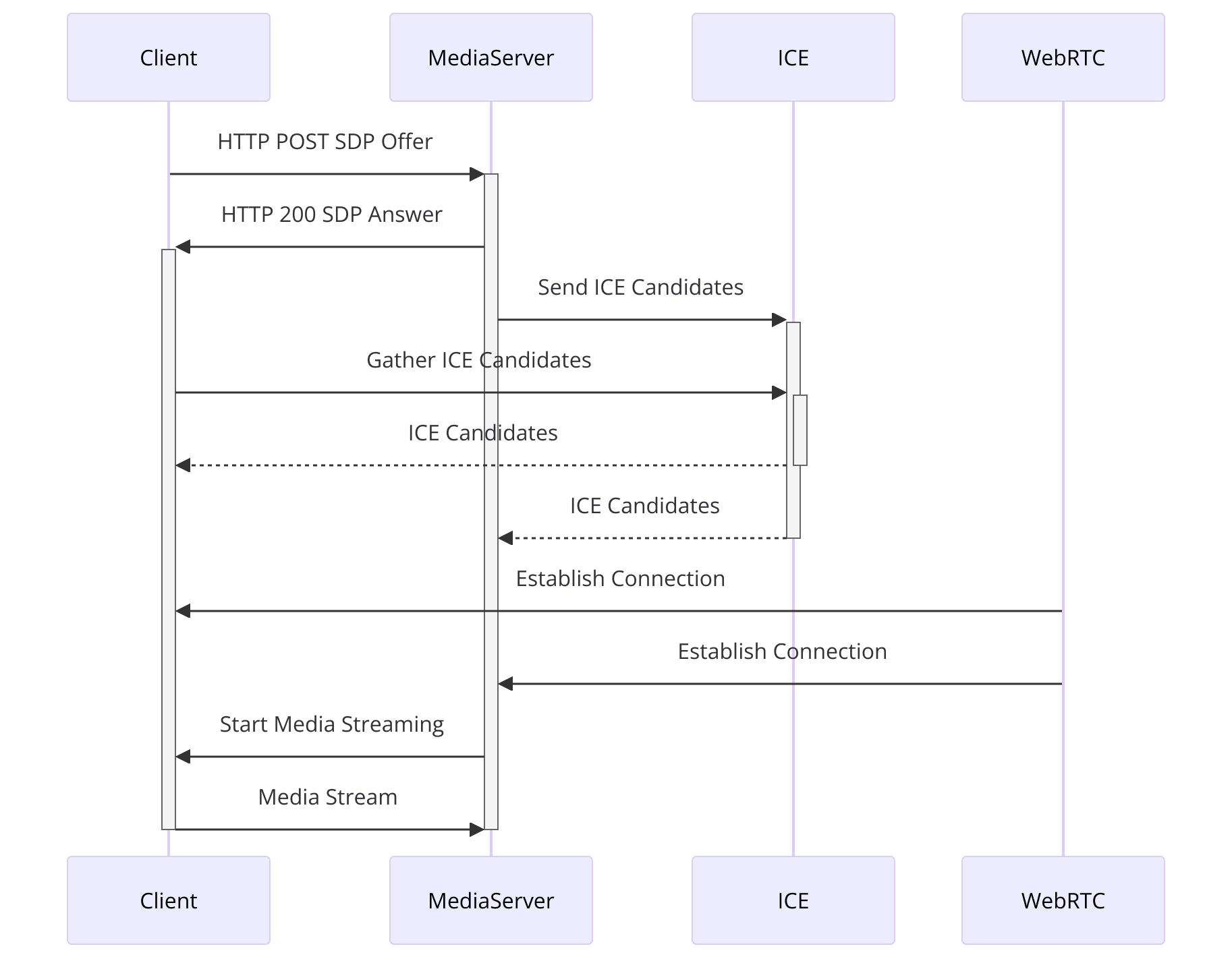What is WHIP (WebRTC-HTTP Ingest Protocol)?
WHIP (WebRTC-HTTP Ingest Protocol) is a standardized protocol designed to simplify the ingestion of WebRTC streams. WHIP allows broadcasters to publish their WebRTC streams to media servers using a streamlined HTTP-based mechanism. This protocol addresses the limitations of traditional WebRTC setups by reducing latency, improving scalability, and ensuring end-to-end encryption.
Key Features of WHIP
- HTTP POST Requests: WHIP uses HTTP POST requests for SDP (Session Description Protocol) offer/answer exchanges, which simplifies the signaling process.
- Load Balancing: WHIP supports HTTP redirections for efficient load balancing, ensuring reliable and scalable streaming.
- Security: With end-to-end encryption and authentication via Bearer Tokens, WHIP enhances the security of media streams.
WHIP Implementation
1<video id="input-video" autoplay muted></video>
2import WHIPClient from "./WHIPClient.js";
3
4const url = "<WEBRTC_URL_FROM_YOUR_LIVE_INPUT>";
5const videoElement = document.getElementById("input-video");
6const client = new WHIPClient(url, videoElement);This JavaScript example demonstrates how to initialize a WHIP client, enabling seamless media ingestion from a web browser.
Technical Insights into WHIP
WHIP is designed to address the complexities of traditional WebRTC setups by streamlining the signaling process. The protocol operates over HTTP, reducing the need for multiple back-and-forth communications typical of WebSocket-based signaling. This simplification results in lower latency and faster connection establishment.
How WHIP Works?

- SDP Offer/Answer Exchange: The WHIP client sends an SDP offer in an HTTP POST request to the media server. The server responds with an SDP answer and ICE candidates, facilitating the connection setup.
- Handling ICE Candidates: WHIP supports various levels of ICE candidates, including Trickle ICE, to ensure robust NAT traversal and connectivity.
- Load Balancing and Redirections: WHIP endpoints can return HTTP 503 status codes during high load, directing clients to alternative servers to balance the traffic load efficiently.
WHIP Client Implementation
JavaScript
1import WHIPClient from "./WHIPClient.js";
2
3const url = "<WEBRTC_URL_FROM_YOUR_LIVE_INPUT>";
4const videoElement = document.getElementById("input-video");
5const client = new WHIPClient(url, videoElement);
6
7client.on('connected', () => {
8 console.log('WHIP connection established');
9});
10
11client.on('error', (error) => {
12 console.error('WHIP connection error:', error);
13});This code snippet demonstrates initializing a WHIP client and handling connection events, providing a robust foundation for implementing WHIP in real-time streaming applications.
What is WHEP(WebRTC-HTTP Egress Protocol)?
WHEP (WebRTC-HTTP Egress Protocol) complements WHIP by managing the outbound delivery of WebRTC streams. WHEP focuses on the egress side, optimizing the delivery of media content to end-users. Like WHIP, WHEP leverages HTTP-based signaling to streamline the connection process and enhance performance.
Key Features of WHEP
- Standardization: WHEP ensures interoperability between different media servers and players, reducing the complexity of setup and maintenance.
- Real-Time Communication: WHEP enables real-time streaming with minimal latency, crucial for applications like video conferencing and online gaming.
- Flexibility: The protocol allows for various SDP offer/answer exchanges, catering to different use cases and environments.
WHEP Implementation
JavaScript
1<video id="playback" controls autoplay muted></video>
2import WHEPClient from './WHEPClient.js';
3const url = "<WEBRTC_PLAYBACK_URL_FROM_YOUR_LIVE_INPUT>";
4const videoElement = document.getElementById("playback");
5const client = new WHEPClient(url, videoElement);This snippet shows how to set up a WHEP client for playback, ensuring efficient media delivery to viewers.
Technical Insights into WHEP
WHEP simplifies the egress of WebRTC streams by standardizing the signaling process and reducing the need for complex configurations. The protocol uses HTTP for signaling, ensuring quick and reliable media delivery to end-users.
How WHEP Works?

- Single HTTP POST Mechanism: WHEP clients send a single HTTP POST request containing the SDP offer. The server responds with the SDP answer and ICE candidates, streamlining the connection setup.
- Flexible SDP Exchanges: WHEP allows for immediate SDP offer delivery or sending a POST request with intent to receive an offer back, providing flexibility depending on the use case.
- Interoperability: The protocol ensures that any WHEP service can communicate with any WHEP player, promoting widespread adoption and reducing integration challenges.
WHEP Client Implementation
JavaScript
1import WHEPClient from './WHEPClient.js';
2
3const url = "<WEBRTC_PLAYBACK_URL_FROM_YOUR_LIVE_INPUT>";
4const videoElement = document.getElementById("playback");
5const client = new WHEPClient(url, videoElement);
6
7client.on('connected', () => {
8 console.log('WHEP connection established');
9});
10
11client.on('error', (error) => {
12 console.error('WHEP connection error:', error);
13});This example showcases how to set up a WHEP client, ensuring efficient and low-latency media delivery to end-users.
By leveraging WHIP and WHEP, developers can significantly enhance their real-time streaming capabilities, providing users with a seamless and interactive media experience. In the next parts, we will explore practical applications, benefits, and challenges of these protocols, and how they shape the future of live streaming.
Applications and Use Cases
Use Cases of WHIP
WHIP (WebRTC-HTTP Ingest Protocol) is transforming how we approach media ingestion in real-time communication. By providing a standardized and efficient method for ingesting WebRTC streams, WHIP opens up various applications across different domains.
Live Streaming
WHIP significantly enhances live streaming by reducing latency and ensuring secure, scalable video delivery. This is particularly beneficial for platforms like sports broadcasting, live concerts, and other real-time events where instant viewer interaction is crucial.
Remote Collaboration
In remote work environments, WHIP enables seamless and secure video conferencing, facilitating real-time collaboration and communication. It ensures that remote teams can work together efficiently without the delays associated with traditional video conferencing tools.
Scalable Video Coding
WHIP supports scalable video coding (SVC), allowing for adaptive video quality based on network conditions and device capabilities. This ensures a smooth viewing experience regardless of the viewer’s internet speed or device performance.
Interactive Applications
Applications such as live auctions, Q&A sessions, and real-time gaming benefit from WHIP’s low latency and high security. These applications require immediate interaction and feedback, which WHIP facilitates effectively.
Use Cases of WHEP
WHEP (WebRTC-HTTP Egress Protocol) complements WHIP by managing the outbound delivery of WebRTC streams. It ensures that media content reaches the end-user efficiently and with minimal delay.
Video Conferencing
WHEP enhances video conferencing platforms by ensuring that video and audio streams are delivered to participants with minimal latency, resulting in a more natural and interactive communication experience.
Online Gaming
For online gaming, WHEP ensures that game streams are delivered in real-time, enabling players to interact seamlessly with each other and the game environment. This low-latency delivery is crucial for maintaining the competitive edge and immersive experience in gaming.
Streaming Services
WHEP improves the efficiency and reliability of content delivery for streaming services. It ensures that viewers receive high-quality video and audio streams without buffering or delays, enhancing the overall user experience.
Remote Education
In remote education, WHEP supports the delivery of educational content in real-time, enabling interactive and engaging learning experiences. Teachers can conduct live classes, and students can participate actively, making online education more effective.
Benefits of WHIP and WHEP
WHIP and WHEP offer numerous benefits that make them valuable additions to the WebRTC ecosystem. These benefits enhance real-time communication and streaming, making them more efficient, secure, and scalable.
Standardization
Both WHIP and WHEP provide standardized protocols for media ingestion and egress, ensuring interoperability between different systems and devices. This standardization simplifies the integration process and reduces the complexity of setup and maintenance.
Low Latency
WHIP and WHEP are designed to minimize latency, making them ideal for applications that require real-time interaction, such as live streaming, gaming, and video conferencing. The reduction in latency ensures a smoother and more responsive user experience.
Enhanced Security
With features like end-to-end encryption and authentication via Bearer Tokens, WHIP and WHEP provide robust security for media streams. This is crucial for protecting sensitive information and ensuring that streams are delivered securely.
Scalability
Both protocols support efficient load balancing and scalable video coding, allowing them to handle large volumes of traffic and adapt to varying network conditions. This scalability ensures that services can grow and accommodate increasing user demands without compromising performance.
Challenges of WHIP and WHEP
Despite their numerous benefits, WHIP and WHEP also face several challenges that need to be addressed to ensure their widespread adoption and effective implementation.
Early Adoption Issues
As relatively new standards, WHIP and WHEP are still in the early stages of adoption. This can lead to inconsistencies in implementation and interoperability issues between different systems and devices.
Managing Edge Cases
Handling edge cases, such as renegotiation, ICE restarts, and network fluctuations, can be challenging. These scenarios require robust mechanisms to ensure that connections remain stable and reliable under varying conditions.
Balancing Latency and Quality
While WHIP and WHEP prioritize low latency, this can sometimes come at the expense of video and audio quality. Finding the right balance between latency and quality is crucial for delivering a satisfying user experience.
Integration with Existing Systems
Integrating WHIP and WHEP with existing systems and workflows can be complex. Organizations need to ensure that their infrastructure supports these protocols and that they can seamlessly transition to using them without significant disruptions.
By understanding these, developers and organizations can make informed decisions about implementing WHIP and WHEP in their real-time communication and streaming applications.
Future of WHIP and WHEP
WHIP (WebRTC-HTTP Ingest Protocol) and WHEP (WebRTC-HTTP Egress Protocol) are poised to revolutionize real-time communication and streaming. Their future potential lies in their ability to provide standardized, low-latency, and secure media transmission, which is crucial for the evolving demands of digital communication.
Widespread Adoption
As the WHIP and WHEP protocols become more standardized, we can expect widespread adoption across various industries. Their interoperability and simplicity will make them a preferred choice for developers and organizations looking to enhance their streaming capabilities.
Advancements in Real-Time Communication
With continuous research and development, WHIP and WHEP will see improvements in handling edge cases, such as ICE restarts and network fluctuations. These advancements will make real-time communication more robust and reliable.
Integration with Emerging Technologies
WHIP and WHEP are likely to integrate seamlessly with emerging technologies like WebTransport, WebCodecs, and WebAssembly, further enhancing their capabilities. This integration will provide developers with more tools to build efficient and high-performance streaming applications.
Expansion into New Use Cases
As WHIP and WHEP protocols mature, they will expand into new use cases beyond traditional streaming and communication. Potential areas include augmented reality (AR), virtual reality (VR), and Internet of Things (IoT) applications, where real-time data transmission is critical.
Conclusion
WHIP and WHEP are groundbreaking protocols that enhance real-time communication and streaming by providing standardized, low-latency, and secure media transmission. Their applications span various industries, from live streaming and gaming to remote education and video conferencing.
As these protocols continue to evolve, they promise to further transform how we interact and consume media in real time. For developers and organizations, adopting WHIP and WHEP offers a pathway to creating more efficient and user-friendly streaming experiences.
Want to level-up your learning? Subscribe now
Subscribe to our newsletter for more tech based insights
FAQ